
The Cathedral Church of St. James is an Anglican cathedral in Downtown Toronto, Ontario, Canada. It is the location of the oldest congregation in the city, with the parish being established in 1797. The church, with construction beginning in 1850 and opening for services on June 19, 1853, was one of the largest buildings in the city at that time. It was designed by Frederick William Cumberland and is a prime example of Gothic Revival architecture.
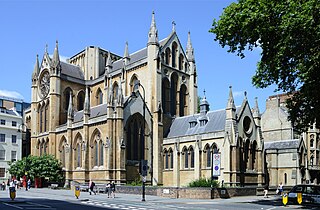
The Church of Christ the King belongs to Catholic Apostolic Church trustees; it is in Gordon Square, Bloomsbury, London. It adjoins Dr Williams's Library and is within sight of University College London. The church is used by the Anglican mission Euston Church for Sunday services and its English Chapel, at its east end, by Forward in Faith for weekday services. It has been a Grade I listed building since 10 June 1954, one of 129 such Christian buildings in London.

Episcopal Church of the Nativity is a church in Huntsville, Alabama. It was built in the Gothic Revival style in 1859. It is noted as one of the most pristine examples of Ecclesiological Gothic architecture in the South. It is also one of the least-altered structures by architect Frank Wills and one of only thirteen surviving houses of worship designed by him in the United States. It was declared a National Historic Landmark in 1990.

All Saints Church is an historic Episcopal church located at 51 Concord Street in Peterborough, New Hampshire, in the United States. Completed in 1914, it is a completely realized example of an English country church as interpreted by the architect Ralph Adams Cram. On December 1, 1980, it was added to the National Register of Historic Places.

Saint Joseph's Roman Catholic Church was a historic Roman Catholic church building in Mobile, Alabama, United States. It served as the parish church for St. Joseph's Parish in the Roman Catholic Archdiocese of Mobile.

St. James Episcopal Church is located on East Main Street in Batavia, New York, United States. It is a stone Neo-Gothic structure built in the early 20th century.
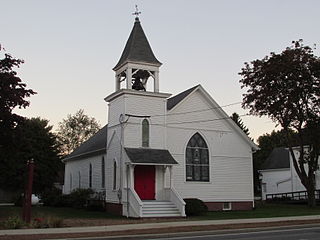
The West Scarborough United Methodist Church, also known as the Dunstan Methodist Episcopal Church, is a historic church on U.S. Route 1 in Scarborough, Maine. The church building, built in 1839 and extensively altered in 1907, is one of the few surviving works of Maine architect and artist Harry Hayman Cochrane. The building was listed on the National Register of Historic Places in 1989 for its architectural significance.

St. Mark's Episcopal Church was a historic church at 9 Summer Street in Augusta, Maine, just west of downtown. The congregation, founded in 1840, occupied an 1886 Gothic Revival stone building designed by Richard M. Upjohn and listed on the National Register of Historic Places in 1984 for its architecture. The congregation moved out in 2015.
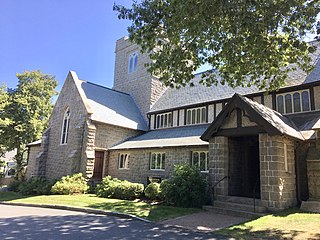
St. Mary's-By-The-Sea is a historic Gothic Revival church at 20 South Shore Road in Northeast Harbor, Maine. Designed by English architect Henry Vaughan and built in 1902, it is one of a number of architect-designed summer chapels built around the turn of the 20th century with funding from wealthy summer residents. The building was listed on the National Register of Historic Places in 2000. Its parish is also responsible for services at Saint Jude's Episcopal Church, another National Register-listed chapel in Seal Harbor.

St. Paul's Episcopal Cathedral, is located in downtown Des Moines, Iowa, United States. It is the cathedral church of the Episcopal Diocese of Iowa. The building was listed on the National Register of Historic Places as St. Paul's Episcopal Church.

Saint Paul's Episcopal Church is a historic building in Columbus, Ohio.
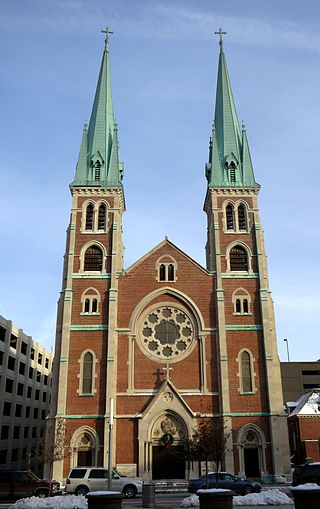
Saint John the Evangelist Catholic Church is a Roman Catholic parish of the Archdiocese of Indianapolis in Indianapolis, Indiana, United States. The parish's origins date to 1837, when it was first named Holy Cross parish. In 1850 it was renamed Saint John the Evangelist parish, and is the oldest Catholic parish in the city and in Marion County, Indiana. Considered the mother of the Catholic parishes in Indianapolis, it played an important role in development of the Catholic Church in the city. Saint John's Church served as the pro-cathedral of the diocese from 1878 until 1906; its rectory served as the bishop's residence and chancery from 1878 until 1892. In 1900 the church served as the site of first episcopal consecration held in Indianapolis.

St Silas' Church is in Preston New Road, Blackburn, Lancashire, England. It is an active Anglican parish church in the deanery of Blackburn with Darwen, the archdeaconry of Blackburn, and the diocese of Blackburn. The church is recorded in the National Heritage List for England as a designated Grade II* listed building.

St. Mary's Episcopal Church is a historic Episcopalian parish in the city of Hillsboro, Ohio, United States. Constructed during the middle of the 19th century, this Gothic Revival church building has been named a historic site.

St. Paul's Episcopal Church is a historic parish of the Episcopal Church in Watertown, Wisconsin,. Its buildings display different phases of Gothic Revival architecture, and in 1979 the complex was added to the National Register of Historic Places for its architectural significance.
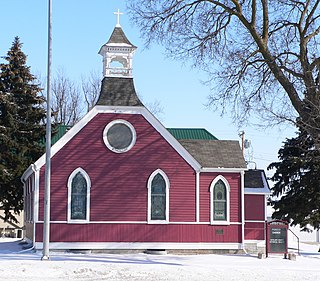
St. Peter's Episcopal Church, now a museum, is a former church at 411 L Street in Neligh, Nebraska. It was built in 1887 and was added to the National Register in 1980.

St Peter's Church is in St Peter's Road, Rock Ferry, Birkenhead, Wirral, Merseyside, England. It is an active Anglican parish church in the deanery of Birkenhead, the archdeaconry of Chester, and the diocese of Chester. The church is designated by English Heritage as a Grade II listed building.

All Saints Church is in the village of Scholar Green in the parish of Odd Rode, Cheshire, England. It is an Anglican parish church in the deanery of Congleton, the archdeaconry of Macclesfield, and the diocese of Chester. The church is recorded in the National Heritage List for England as a designated Grade II* listed building.

St Lawrence's Church is in Garstang Road, Barton, Preston, Lancashire, England. It is an active Anglican parish church in the diocese of Blackburn. The church was built in 1895–96, and was designed by R. Knill Freeman. It is constructed in sandstone, and consists of a nave, aisles, a chancel and a southwest steeple. The church holds services on Sundays and Wednesdays. It is recorded in the National Heritage List for England as a designated Grade II listed building.

All Saints' Episcopal Church is a historic Episcopal parish church in Austin, Texas, United States. Built in 1899 on the edge of the University of Texas at Austin campus, the church has long-standing connections with the university's student body and faculty. The chapel was a project of Episcopal Bishop George Herbert Kinsolving, whose crypt is located under the church. It has been designated as a City of Austin Historic Landmark since 1980 and a Recorded Texas Historic Landmark since 2014, and it was listed on the National Register of Historic Places in 2015.
























